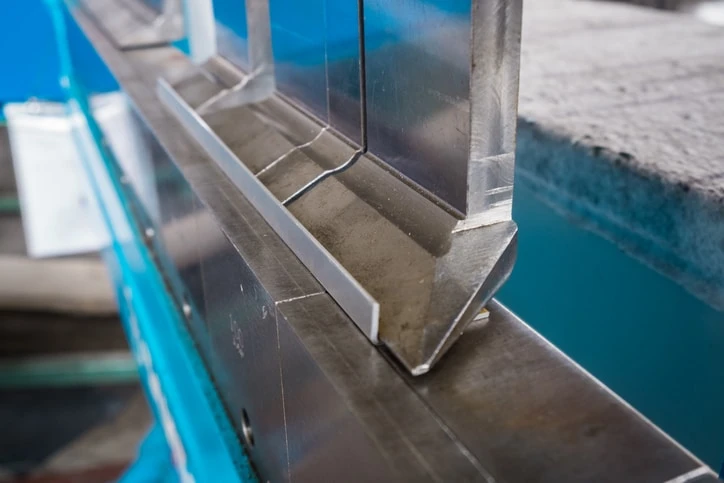Have you ever marveled at the intricate designs and durable structures crafted from flat metal sheets? The secret behind these transformations is metal bending.
This method, essential to both construction and manufacturing, allows for the remarkably accurate production of forms and angles. Metal bending is more than a method; it’s a doorway to creativity that opens possibilities for building intricate components and robust assemblies.
This blog covers the process of bending sheet metal, emphasizing the necessary methods and equipment to achieve precision. We’ll provide the know-how to complete your metalworking projects, from comprehending fundamental sheet metal bending processes to investigating sophisticated folding ways.

What is Metal Bending?
Metal bending is a process that reshapes flat sheet metal into desired angles and forms through various techniques. It involves applying force to the metal, causing it to bend without breaking, enabling the creation of complex shapes and structures used in numerous applications.
Different Sheet Metal Bending Methods
This section will explore the different sheet metal bending methods, unveiling techniques from air to roll bending that are essential for fabricators and hobbyists aiming to master metal manipulation for creative and precise projects.
Bending
A bare sheet metal forming technique is bending, which involves applying force to produce a bend at a particular angle. This adaptable process enables a wide variety of forms and dimensions, making it appropriate for several uses, including building materials and automobile components.
Air Bending
Air Bending involves placing sheet metal on a die and pressing a punch into it without the punch and die fully touching. This method requires less force and allows for greater flexibility in bending angles with a single set of tools. It’s commonly used where varying-angle bends are needed within the same part.
Bottoming
Bottoming, or V-die bending, occurs when the sheet metal is pressed into the die until it bottoms out against the tool, creating a precise bend angle. This technique offers high accuracy and repeatability, which is ideal for parts requiring strict specifications.
Wipe Bending
Wipe bending or edge bending, involves pressing the workpiece against a die with a wiping flange and bending the metal over the edge. This method is beneficial for creating small flanges or bends close to a profile edge but requires significant force and specialized tooling.
Roll Bending
Roll-bending uses a series of rollers to bend the sheet metal into a radius gradually. This method is perfect for creating large, smooth arcs or circles. This method often fabricates tanks, cylinders, and other rounded components.
Rotary Draw Bending
Using a rotary draw machine, the workpiece is clamped between a mandrel and a die before being bent around the mandrel. This method is highly accurate and perfect for parts that need to be bent with tight radiuses; it is frequently used to bend pipes and tubing for various industrial uses.
Process of Sheet Metal Bending
Sheet metal bending is a complicated process that has to be done with care and accuracy at each phase to ensure that the finished product fulfills the required criteria. This is how it happens:
Strengthen The Substrate
Initially, the sheet metal itself must be prepared. This involves ensuring the metal is of the right thickness and material properties for bending. It’s not about altering the metal but ensuring it’s suitable for bending sheet metal techniques.
Reduce Effects of Friction and Corrosion
Applying a protective layer during the bending operation can minimize the metal’s wear. This process is crucial for maintaining the sheet metal’s quality both during and after bending.
Create Electrical Conductivity
This procedure pertains to specific applications where the bent metal must efficiently transmit electricity. Before bending, the metal’s coating or composition might be changed.
Enhance Chemical Resistance
Preparing the metal to withstand chemicals is crucial, particularly if the finished product will be placed under hostile conditions. This guarantees the bent metal parts’ lifetime and robustness.
Upgrade Appearance
This process can also address the aesthetic aspect of the bent metal. Finishing techniques post-bending can significantly improve the visual appeal of the sheet metal.
Improve Paint Cohesion
For painted metal products, it is key to ensure that the surface is primed correctly before painting. This involves preparing the bent metal to accept paint, enhancing adherence and finish.
Clean The Surface
It’s important to keep the metal clean before, during, and after bending. This guarantees the quality of the final product and prevents bending process flaws.
Tips for Sheet Metal Bending
Selecting the right tools and materials is paramount for successful sheet metal bending. To prevent damage, opt for a bending tool that matches the thickness and type of metal. Understanding the material’s properties, like its bend radius, can help avoid cracking or breaking.
Precision is vital, so always measure and mark your bend lines accurately. Use a press brake for uniform bends on longer sheets. Consider using a combination of techniques, such as air bending and bottoming, to achieve the desired angles and shapes for intricate projects.
Lubricating the metal can reduce friction, enhancing the bending process. Lastly, practice makes perfect; experiment with scrap metal to refine your technique before working on the final piece.
The Most Frequently Asked Questions (FAQs) – Sheet Metal Bending
What is the Bend Rule for Sheet Metal?
The bend rule is a guideline that helps predict how the metal will stretch during bending. Calculating the correct placement of bend lines is crucial to ensure the final dimensions are accurate. This rule varies depending on the type of metal and its thickness.
How Do You Calculate Bend?
Bend height is the vertical distance calculated from the material’s bottom to the band’s highest point. This dimension is essential when creating parts with tight tolerances to fit together and ensure that the bent portion fits as intended in the overall design.
What is Bend Height?
The vertical distance from the material’s bottom to the bend’s apex is called bend height. This measurement is crucial to ensure the bent portion fits as intended in the overall design, particularly when making components with tight tolerances for fitting together.
Mastering the Art of Sheet Metal Bending
Bending sheet metal is crucial for creating intricate and varied shapes in the fabrication industry. We’ve looked at numerous bending techniques, such as the accuracy of air bending and the adaptability of roll bending, and we’ve provided valuable tips to help you with your bending process. Understanding fundamental ideas like the bend rule, bend calculation, and bend height is necessary to get accurate and desired results.
Keep the complexity of sheet metal bending from your projects. Contact Eckstrom Industries today for expert guidance and support. To learn more about our resources, go to our website or contact us directly for project consulting. Allow us to assist you in achieving excellence, efficiency, and precision in all your metal bending projects.

